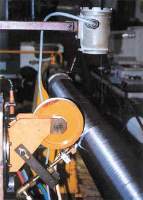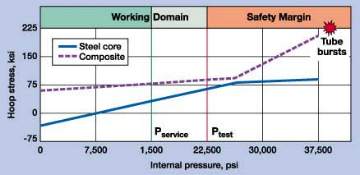FRANCE: Hybrid tubes for choke and kill lines
April 2001 Vol. 222 No. 4 Feature Article FRANCE: Hybrid tubes for choke and kill lines C. Gaillard and J. Guesnon , IFP, France Technology
FRANCE:Hybrid tubes for choke and kill linesC. Gaillard and J. Guesnon, IFP, France Technology is underway to reduce riser mass by replacing present choke and kill lines by lighter tubes. This is achieved by using hybrid tubes composed of a steel core, hoop-wound with a carbon / polyamide thermoplastic strip, Fig. 1.
A 4-1/2-in. ID, hybrid choke and kill line must withstand high internal service pressures up to 15,000 psi, as well as axial loads. Such lines would normally require 1-in. or larger wall thickness. However, use of carbon polyamide strips, hoop-wound around the steel core, allows the wall thickness to be reduced to 1/2-in. The working principle of the hybrid tubes is quite simple. The carbon strip provides a pre-stress in the steel. During the first stage, the steel core resists internal pressure until hoop stresses reach the yield stress of the steel. According to specifications, an internal pressure of at least 22,500 psi (test pressure) must be reached before this occurs, Fig. 2. Then, any further increase in internal pressure is primarily resisted by the composite hoop windings. The strip works under axial forces due to circumferential winding. Failure of the hybrid tube occurs first when the fibers of the strip are broken.
Many studies have been carried out at Institut Français du Pétrole (IFP) to determine the number of carbon layers and the tension that should be applied to the strips to meet particular specifications for choke and kill lines. When the design is optimal, total weight of the hybrid tube is 30 ppf (45 kg/m), instead of 60 ppf (90 kg/m) for the 1-in., all-steel tube. Many prototypes of this design have been built and tested extensively at IFP. The various tests have been chosen to be representative of the entire working life of choke and kill lines, such as simple burst, burst with temperature, long term pressure, cyclic pressure, cyclic temperature and external pressure. The critical transition sections, between the hybrid tubes and end fittings, have been carefully studied. Tests on this particular part have been carried out to check the designed geometry (angle, number of strips). The present stage of the project is to build three lines (each 70 ft long), fit them to an operational riser joint and test them under actual service conditions. Tests will be carried out for a year, either on the Pride Africa or Pride Angola drillships operating off Angola. The main advantage of hybrid tubes is the reduction of riser mass. These tubes are 50% lighter than equivalent, all-steel tubes, which leads to a reduction of about 500 tons for a 3,000-m (9,845 – ft) riser, including the reduction of buoyancy module weight. This leads to many benefits for the riser in the form of reduced buoyancy, reduced top tension, improved dynamic behavior and reduced fatigue. For riser upgrade considerations, existing 10,000-psi lines can be replaced by hybrid, 15,000-psi tubes, without increasing weight. Similarly, existing 3-in. ID lines can be replaced by hybrid 4-in. or 4-1/2-in. ID lines. Finally, risers equipped with hybrid tubes built
according to the IFP technology are well suited to ultra-deep drilling in any environment, from mild to very
harsh. |




